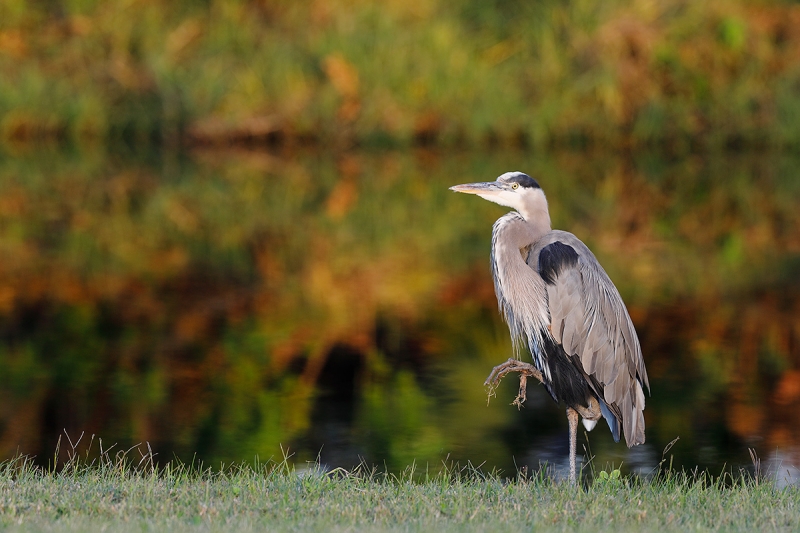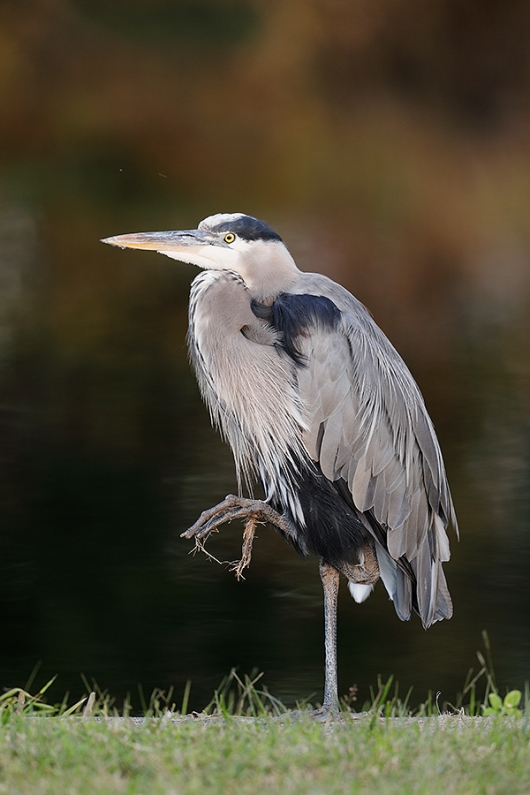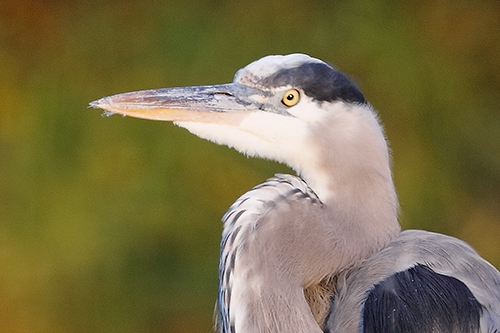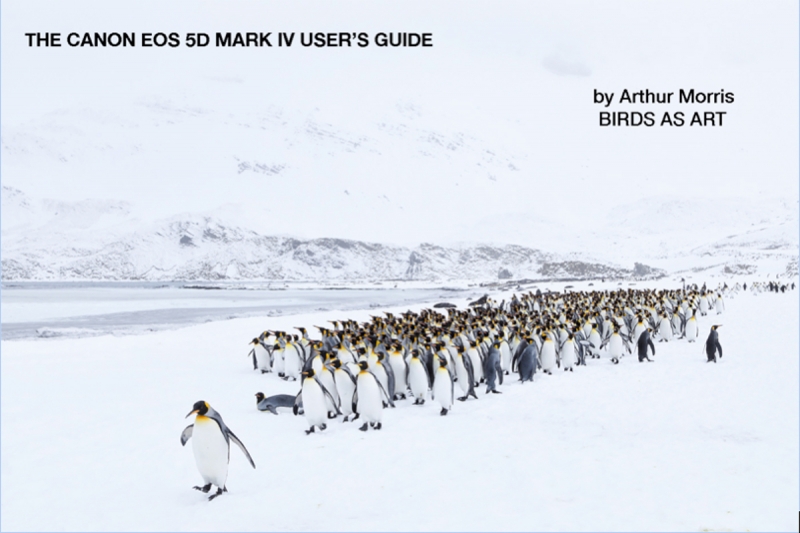Stuff
As most of you know, I finally put the icing on the 5D Mark IV User’s Guide on Tuesday. Even that took longer than I had expected. You can order a copy here or learn more below. It sure was a lot of work. 🙂 Remember: if your purchase a 5D IV now using this link, you can send me your B&H receipt via e-mail and receive a free copy of the guide.
I had an Osprey on the tall, skinny perch early on Tuesday morning. I worked it from the car with 600 II/2X III/5D IV combo on the BLUBB. As I was tired of clipping the wings on the raised-wing take-off images, I held my rig vertically. So what does the bird do when a grackle flies by too closely? It raises both wings to the side and poses perfectly — right down sun angle of course — with both underwings evenly lit for five seconds. But working vertically I wold have clipped both wingtips. By the time I rotated to horizontal, the handsome bird was just re-folding its wings. There is always tomorrow … Again I took a walk on a long pier with my 400 DO II/1.4X III/1DX II but there was very little going one. I swam my regular, slow 3/4 mile (66 lengths of the pool) at 3:30pm and then headed down to the lake where I had a few almosts with some perched grackles at sunset.
Today, Wednesday, December 27th, 2017 (but not for long), I will be working on some travel plans and on lots of IPT stuff (both old and new).
There are lots of questions below for you to consider; don’t be lazy. Thanks to Eugen J. Dolan, Doug West, David Policansky, Larry Brown, Warren H, and Elinor Osborne for leaving comments at yesterday’s Black and White and Blue and Pewter Abstracts blog post here.
Click on the logo-link above for great holiday savings!
$300 off on the Canon 100-400 II!
$300 off on the Canon 100-400 II!
The Streak
Today makes one hundred fifty-one days in a row with a new educational blog post! This blog post took about 90 minutes to prepare. With all of my upcoming free time (or not …), the plan right now is to break the current record streak of 480 … Good health and good internet connections and my continuing insanity willing.
Click here for Amazing 5D Mark IV Bundles and Deals
Booking.Com
Booking.Com came through for me twice again recently with both the DeSoto Fall IPT and next July’s UK Puffins, Gannets, and Bempton Pre-trip room reservations. And all the rates were great. If you’d like to give Booking.Com a shot, click here and you will earn a $25 reward. Thanks to the many who have already tried and used this great service.
Gear Questions and Advice
Too many folks attending BAA IPTs and dozens of folks whom I see in the field, and on BPN, are–out of ignorance–using the wrong gear especially when it comes to tripods and more especially, tripod heads… Please know that I am always glad to answer your gear questions via e-mail. Those questions might deal with systems, camera bodies, accessories, and/or lens choices and decisions.
|
|
|
This image was created on the afternoon of Sunday, December 17 from my Sequoia with the BLUBB-supported Canon EF 600mm f/4L IS II USM lens, the Canon Extender EF 1.4X III, and the new Canon EOS 5D Mark IV. ISO 400. Evaluative metering -1/3 stop: 1/80 sec. at f/9 in Manual mode was a tactical error. AWB at 5:13pm in rich, late afternoon light. Three AF points to the right of the center AF point/AI Servo/Manual selection/Shutter Button AF as framed was active at the moment of exposure. The selected AF point fell on the back of the bird’s lower neck, pretty much on the same plane as the crane’s eye. LensAlign/FocusTune micro-adjustment: -1. Image #1: Great Blue Heron on edge of canal |
Lucky Look-Back
This handsome GBH was sitting on the edge of one of the many canals at ILE in a spot that I almost never check or even see. I am not sure why I looked to my right and well back as I headed down to check The Perch at sunset. But there was this nice bird so I figgered that I would photograph it. There will be lots of questions today so do consider leaving a comment if you know any or all of the answers. 🙂
The Tactical Error?
When I wrote this, em>ISO 400. Evaluative metering at zero: 1/80 sec. at f/9 in Manual mode, what was my tactical error?
Image #1
What are the strengths of Image #1? The weaknesses?
|
|
|
This image was also created on the afternoon of Sunday, December 17 from my Sequoia with the BLUBB-supported Canon EF 600mm f/4L IS II USM lens, the Canon Extender EF 1.4X III, and the new Canon EOS 5D Mark IV. ISO 400. Evaluative metering at zero: 1/80 sec. at f/5.6 in Manual mode. AWB at 5:18pm after a cloud covered the sun. One AF point to the left and three rows up from the center AF point/AI Servo/Expand/Shutter Button AF as framed was active at the moment of exposure. The selected AF point fell on the spot where the bird’s white chin touched the folded neck, pretty much on the same plane as the crane’s eye. LensAlign/FocusTune micro-adjustment: -1. Image #2: Great Blue Heron on edge of canal |
Exposure Questions
Exactly how many stops different were the two exposure?
Why did I need -1/3 stop EC for Image #1?
Image #1
What are the strengths of Image #2? The weaknesses?
Your Opinion Please
Which image has the nicer background? Which image has a more pleasing composition? Overall, which image is stronger? Why?
|
|
|
This is an unsharpened 500 pixel wide crop from the image viewed at 100%. No Eye Doctor work, no Contrast Mask on the face or anywhere. |
For Jay
Does this look sharp to you?
|
|
The 5D Mark IV User’s Guide |
The 5D Mark IV User’s Guide
$48.00. Order yours here now.
Regular readers of the BAA blog know that I have been loving my 5D Mark IV ever since I got my hands on one about two years ago. Right now I own and use three of them. I love the light weight, the high quality image files, and the great autofocus system that is the same as with the vaunted 1DX II. I use my 5D IV bodies for everything I shoot: birds, flowers, wildlife, scenics, and Urbex and architecture.
The 5D Mark IV User’s Guide has been in production for more than a year as I continued to learn the camera’s intricacies.
As with all BAA Camera User’s Guides you will learn a ton. If you have trouble deciphering the 676 page 5D IV camera body Instructional Menu you will be delighted with this new guide. I explain everything that you need to know about your 5D IV in my clear, concise, informal, easy-to-follow style. You will learn about the top LCD and all camera controls and buttons, about the 5D Mark IV drive modes, how to manually select an AF point, how and why to choose an AF Area Selection Mode (with explanations and sample images), and how to access the various Menus and Menu items.
The guide covers almost all the Menu items and Custom Functions including the following: Image Quality, Auto Lighting Optimizer, Highlight Tone Priority, the AF Configuration Tool (including new information on the Custom Case settings that I have developed and used), Tracking sensitivity, Acceleration/deceleration tracking, AF point auto switching, Lens drive when AF impossible, Orientation linked AF point (I love this feature on the 5D IV!), Highlight alert, Histogram display, Auto rotate, Custom Shooting Mode set-up, Safety shift, using the Q button, setting up rear focus, and lots more.
The guide includes an image gallery with illustrative, educational captions and, for the first time ever, a Cheat Sheet, a concise summary of all menu items with the appropriate settings.
Please note: Some Menu items are not mentioned in the guide either because they deal only with video (which is not covered in this guide) or because they are irrelevant to nature photography. Each of those should be left at the default setting. You will receive your PDF file via e-mail.
You can order a copy of the 5D IV guide by clicking here.
What They are Saying
From Mitch Haimov, the principal reviewer
Thank you for your new 5D IV guide. You’ve put a lot of useful information in there. I appreciate the time and effort you devoted to this project!
Dane Johnson, who caught some nasty typos!
I think that the guide is very well done and packed with lots of useful information, as is usual. The images speak for themselves.
From Lee Sommie, 5D IV B&H Purchaser
This 5D Mark IV User’s Guide is fantastic! Your conversational writing is fun and easy to read. Your explanations of 5D Mark IV functions will appeal to novice and expert alike. This guide is the jump start for all 5D Mark IV wildlife photographers. I can’t put it down. The wait was worth it!
Support the Blog
Please help support my (stupendous) efforts here on the blog by remembering to click on the logo link above each time that you shop Amazon. That would be greatly appreciated. with love, artie
If In Doubt …
If in doubt about using the BAA B&H affiliate link correctly, you can always start your search by clicking here. Please note that the tracking is invisible. Web orders only. Please, however, remember to shoot me your receipt via e-mail.




Please Remember to use my Affiliate Links and to Visit the New BAA Online Store 🙂
To show your appreciation for my continuing efforts here, we ask, as always, that you get in the habit of using my B&H affiliate links on the right side of the blog for all of your photo and electronics purchases. Please check the availability of all photographic accessories in the New BIRDS AS ART Online Store, especially the Mongoose M3.6 tripod head, Wimberley lens plates, Delkin flash cards and accessories, and LensCoat stuff.
As always, we sell only what I have used, have tested, and can depend on. We will not sell you junk. We know what you need to make creating great images easy and fun. And please remember that I am always glad to answer your gear questions via e-mail.
I would of course appreciate your using our B&H affiliate links for all of your major gear, video, and electronic purchases. For the photographic stuff mentioned in the paragraph above, and for everything else in the new store, we, meaning BAA, would of course greatly appreciate your business. Here is a huge thank you to the many who have been using our links on a regular basis and those who will be visiting the New BIRDS AS ART Online Store as well.
Be sure to like and follow BAA on Facebook by clicking on the logo link upper right. Tanks a stack.
Typos
In all blog posts and Bulletins, feel free to e-mail or to leave a comment regarding any typos or errors. Just be right :).




















Hey Arthur, could have been wide open instead of f9. Really like the background in image #1. Looks like fall colors for some reason. Is it fall color time in Florida right now? Image number two has that classic clean graphic look. The cut off foot doesn’t help. Not much you could do about that.
Hi John and thanks for commenting. Yes, it is fall color time here but it does not last very long. The feet in both images are not “cut off,” they are hidden by the grass. Not much I could do about that. 🙂
with love, artie
Hi Artie.
I’m in catchup mode so some of the answers are probably already done. Without looking at the others answers the tactical error is fstop tooo small. you could get f 5.6 out of the 600/4 1.4 TC combination so that would have given you more SS and blurred the BKGR .
strengths and weaknesses of the image. good lower clean edge of frame. Nice pose of the heron and nice head angle. bird nicely positioned in relation to the canal background without the shore line cutting thru the head.
Bkground is too defined. Some of the left hand side of the frame could be cropped. I prefer your more clean tight and graphic images.
The exposure difference by the numbers image one f9, 1/80th at iso 400 vs image two f 5.6,1/80th at iso 400. Difference should be 1 1/3 stops more in image two. Although I am struggling to see that much difference to my eye.
Regards
David.
Pretty darned good as usual. The exposure for the bird is perfect in both frames; I think that you might have missed the part about a cloudy covering the sun …
with much love and best wishes for a great 2018.
artie
The stops difference…I’d say one full stop.
I’ll probably shoot myself in the foot on this is,
due to the fact you were in Manual Mode, the
exposure compensation doesn’t matter.
Doug
Geez, the evaluative metering. I really need
to see an eye doctor.
Doug
As far as the “one full stop,”, you also need to study up on your shutter speed/aperture value relationships …
with love, artie
Good morning, Artie. Image # 2 is much stronger; better composition, better background. The tactical error in #1 was shooting at f/9 when you could have shot at f/5.6, which would have had 2 benefits: (a) faster shutter and (b) better (more OOF) background. You needed – EC in image 1 because the background is darker than the bird, and the background dominates what the meter reads. Without -EC, the bird would have been overexposed. Difference in exposure is the difference between f/9 and f/5.6, or a bit more than 1/2 a stop. If image #2 were mine, I think I’d have put the bird a little more to the right in the frame.
Thanks Dr. Fish, Good on the tactical error … What part of the bird would have been overexposed??? You need to study up on your shutter speed/aperture value relationships …
Many thanks for your thoughtful reply. With love, artie
Hi, Artie. What error have I made in my shutter speed/aperture relationship? Both images were shot at 1/80 second; only the aperture changed. ??
On the bird in image 1, the whites on the head would have been blown and the grey feathers would have been too light.
#1 image. Tactical error. Considering that bird was at quite some distance (840 mm focal length) and parallel to the lens, you could have shot wide open at f5.6. This would have allowed faster SS at the same time. Bird eyse look little soft, you would have had sharper image and silkier bokeh.
Hi Jay,
Good on the tactical error part 🙂 And good on the faster SS. The eye is plenty sharp enough for me.
I added an unsharpened crop of the face to the blog post just for you. Let me know what you think.
wtih love, artie
If #1 was at ec -1/3 and #2 was as ec 0, there is 1 2/3 stops difference. #1 needed a darker exposure because of mostly darkish background. The light heron was small and off center.
In #2 the light heron is centered and predominates so it needs a lighter exposure.
Both compositions look very good to me but I like #2 better because the viewer has a closer connection with the bird and the background is much smoother. And I like the line of the far shore not showing.
Hi Elinor, You exposure answers (in part) illustrate many common misconceptions . Be sure to see the follow-up post.
with love, artie
Hi Artie,
your tactical error was to have 0 exposure compensation for an image with a slightly dark background. You needed -1/3 exposure compensation in order to not blow out the whites on the bird, given that the bird was in direct sunlight.
Strength of image #1: It shows a bird in excellent position in a great habitat. Weakness: I would crop the image slightly from the top and right and would darken the bright area in front of the bird.
The strength of image #2 is that the background appears to be darker and more blurred. This makes the bird stand out more clearly. Overall it is a great image with excellent pose of the bird showing great detail. The only weakness I can see is that the bird could have been moved a little further back in the frame and the image could be cropped from the top.
Image #2 has the better background (darker, more blurred). Both images are great compositions. Overall I prefer image #2 because the bird stands out better with the darker background. It also shows more detail in the bird because it is much larger in the frame.
Dietmar
Hi Dietmar, I actually corrected that right after I published the post 🙁 But there is a major tactical error in this: “ISO 400. Evaluative metering -1/3 stop: 1/80 sec. at f/9 in Manual mode was a tactical error.”
Many thanks for the rest.
with love, artie
Hello Arthur,
thank you for the work in the article again. I really love the content.
As for the picture, #2 is stronger all around as the eye only goes to the bird and briefly to the ground for context of where the bird is.
Background brightness in the first image distracts and draws away from the main subject. Also i noticed that the brightness seems to narrow to a point in the center of the photo, where you would expect the subject to be. It’s not there so everything seems to be slightly off. All this is in context to the second image.
thanks again.
Thanks for leaving a comment, Landon,and for your kind words. Why would you want to put a small-in-the-frame subject in the middle of the frame?
with love, artie